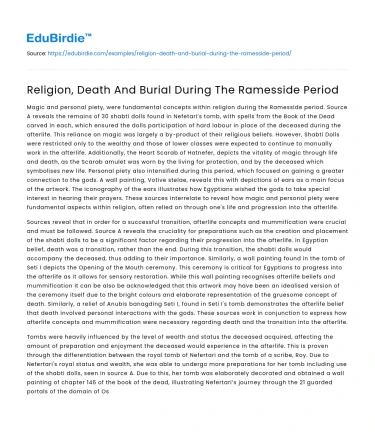Magic and personal piety, were fundamental concepts within religion during the Ramesside period. Source A reveals the remains of 30 shabti dolls found in Nefetari’s tomb, with spells from the Book of the Dead carved in each, which ensured the dolls participation of hard labour in place of the deceased during the afterlife. This reliance on magic was largely a by-product of their religious beliefs. However, Shabti Dolls were restricted only to the wealthy and those of lower classes were expected to continue to manually work in the afterlife. Additionally, the Heart Scarab of Hatnefer, depicts the vitality of magic through life and death, as the Scarab amulet was worn by the living for protection, and by the deceased which symbolises new life. Personal piety also intensified during this period, which focused on gaining a greater connection to the gods. A wall painting, Votive stelae, reveals this with depictions of ears as a main focus of the artwork. The iconography of the ears illustrates how Egyptians wished the gods to take special interest in hearing their prayers. These sources interrelate to reveal how magic and personal piety were fundamental aspects within religion, often relied on through one's life and progression into the afterlife.
Sources reveal that in order for a successful transition, afterlife concepts and mummification were crucial and must be followed. Source A reveals the cruciality for preparations such as the creation and placement of the shabti dolls to be a significant factor regarding their progression into the afterlife. In Egyptian belief, death was a transition, rather than the end. During this transition, the shabti dolls would accompany the deceased, thus adding to their importance. Similarly, a wall painting found in the tomb of Seti I depicts the Opening of the Mouth ceremony. This ceremony is critical for Egyptians to progress into the afterlife as it allows for sensory restoration. While this wall painting recognises afterlife beliefs and mummification it can be also be acknowledged that this artwork may have been an idealised version of the ceremony itself due to the bright colours and elaborate representation of the gruesome concept of death. Similarly, a relief of Anubis banagding Seti I, found in Seti I's tomb demonstrates the afterlife belief that death involved personal interactions with the gods. These sources work in conjunction to express how afterlife concepts and mummification were necessary regarding death and the transition into the afterlife.
Save your time!
We can take care of your essay
- Proper editing and formatting
- Free revision, title page, and bibliography
- Flexible prices and money-back guarantee
Tombs were heavily influenced by the level of wealth and status the deceased acquired, affecting the amount of preparation and enjoyment the deceased would experience in the afterlife. This is proven through the differentiation between the royal tomb of Nefertari and the tomb of a scribe, Roy. Due to Nefertari's royal status and wealth, she was able to undergo more preparations for her tomb including use of the shabti dolls, seen in source A. Due to this, her tomb was elaborately decorated and obtained a wall painting of chapter 146 of the book of the dead, illustrating Nefertari’s journey through the 21 guarded portals of the domain of Osiris. The more extravagant representation of this ritual was to show her close nature with the gods and to highlight her elevated status through the adorned walls and spacious tomb. Contrastingly, Roy’s tomb was small and lacked such intrinsic, colourful scenes. Arched stelae found on the west wall, reveals his praise to the solar god, Ra. However, it contains rapid, informal sketches that have faded over time, making it an unfinished burial design. Due to its incomplete nature, it is subject to misinterpretation, affecting our level of knowledge. These sources cooperatively reveal how tombs during this period differed substantially in architecture and decoration, due to status and wealth.






 Stuck on your essay?
Stuck on your essay?

